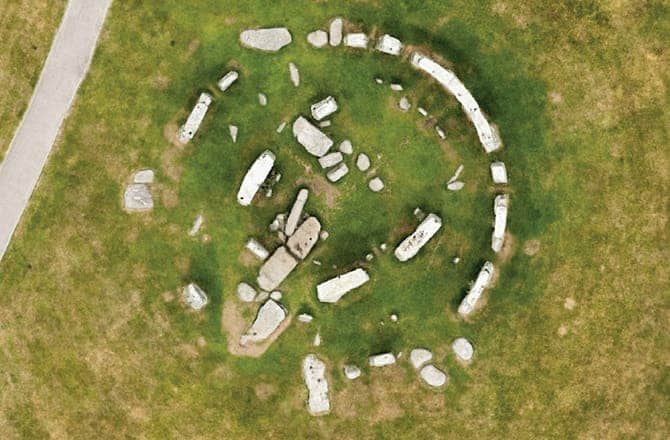
This aerial photograph shows patchmarks whose position suggest there were once laid stones there. Photo: English Heritage
Stonehenge is one of Britain’s greatest national treasure, but while magic, myth and mystery surrounding the monumental site has been time and time again dispelled by science, there is still much to learn. One major debate regarding Stonehenge is whether or not the site once formed a complete circle. Now, a short hosepipe and a scientist’s keen eye might settle the issue once and for all: the monolithic complex indeed closed a circle.
Going in circles
More than nine hundred stone rings exist in the British Isles, and scholars estimate that twice that number may originally have been built. Scholars usually classify these types of megalithic structures as rings rather than circles, because the rough proportions for the different shapes are 2/3 true circles, 1/6 flattened circles, 1/9 ellipses, and 1/18 eggs. Stonehenge, however, is roughly circular.
The Wiltshire monument was likely built in several stages with “the unique lintelled stone circle being erected in the late Neolithic period around 2500 B.C.,” according to the English Heritage. The site is comprised of massive central trilithons, smaller bluestone settings, sarsen circle capped by lintels, outer bank and ditch. For centuries scientists have investigated Stonehenge, but the passing of many years since it was last used as a site of worship and astrology had left it marks. The debate still ranges on whether part of the site was left intentionally incomplete or whether it was once complete to describe a full circle.
One dry summer in 2013 may have helped shed light on the matter. Tim Daw, an English Heritage steward, observed marks of parched grass in an area that had not been watered (the hosepipe was too short to reach it). Upon closer inspection, Daw found these marks appeared in the sarsen circle exactly where stones were expected to stand.
In places where stone structures or holes used to be, vegetation grows differently than that in its vicinity. That’s because most often than not buried or once-buried structures interfere with soil permeability, so plants growing on top develop in a characteristic manner.
“Plants that may have initially benefited from the easily available rooting and moisture in disturbed ground fail as the soil dries out, whilst the shorter-rooting surrounding plants manage to survive by extracting water directly from the porous chalk,” Daw and colleagues wrote.
The researchers involved immediately launched a survey using Differential Global Positioning System technology, however due to time constraints the equipment couldn’t be deployed during the same conditions when the parched grass marks were first encountered.
“Ideally the survey would have differentiated between marks caused by parching –- the majority -– and those caused by lusher growth,” Daw and colleagues wrote.
“It would have also have graded the marks into ‘definitive’, ‘probable’ and ‘possible’ categories. This was not possible, and the result must therefore be treated with caution,” they added.
The English Heritage hopes to access historical aerial photography from summer seasons and schedule surveys when the weather is right. Where digs and geophysical methods failed to miss this highly important Stonehenge piece, the growth of a simple parched grass may have helped reveal what was under debate for centuries. You just have to keep your eyes opened.
Findings appeared in the journal Antiquity.









